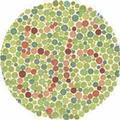|
Color Blindness Genetics Information
When it comes to color blindness genetics is the culprit 99.9 percent of the time. The ability of our eyes to perceive and process color is something that's coded into our genes. However, if one person has a deficiency or a malfunction with those genes, the trait will pass down to their son or grandson. The genes that control this are a bit like those that control eye color or hair color. You rarely have a couple that both have red hair, yet who have a son with blonde hair. The genetic coding of the two parents will normally create a combination of the genes, resulting in a unique combination for their son or daughter. However, it is possible, even though it's extremely rare, for these traits to scramble when the genes are combining, resulting in a trait in the offspring that wasn't present in either of the parents. In the case of color blindness genetics sometimes plays tricks as it goes down the family line. It's not uncommon for the genes that cause Color Blindness to skip one or even two generations before making an appearance again. That's why, unless you know for a fact that none of your previous ancestors were color blind, you can never be completely sure that your son won't come out with a color vision deficiency. The cells in The Retina that process light are called the rods and cones. The ones responsible for color in particular are called the cones, and these are coded through the genes to perform very specific actions with different wavelengths of light that signify the visual color spectrum. When the coding is wrong, however, the results can be unexpected.
Most of the time, this results in Vision Color Blindness , which is when the eyes aren't able to see one or more color wavelengths, resulting in a deficiency of that color. The brain will then compensate by producing more of a different color in its place. This is actually the way colorblind people see the world. They do not see everything, as white and black or just shades of gray as a lot of people seem to think. Instead, the colors are more or less the same, although certain colors might be brighter or more faded, and some might be replaced altogether. With Red Green Color Blindness , a person isn't able to distinguish between red and green. To them, the colors appear to be the exact same hue. Red green color blindness genetics will tell us, is the most common type of color blindness there is. It's estimated that 99 percent of people who are diagnosed as colorblind have red green color blindness. The second most common type is known as blue yellow color blindness, and the exact same thing happens; patients are unable to tell the difference between the red and blue wavelengths than go into their Retinas. Contrary to popular belief, Color Blindness is not a handicap. At least 1 in 10 men likely have the condition.

Subscribe to EyeSight Vision Care! , our monthly newsletter with in depth information to help you keep up to date on how to Protect Your Eyesight with a free bonus. Fill out the form below. You'll then receive an email asking you to confirm that you subscribed. You'll always have the option to unsubscribe at the click of your mouse. Color Blindness Genetics to Color Blindness Test Charts
|
More Information















